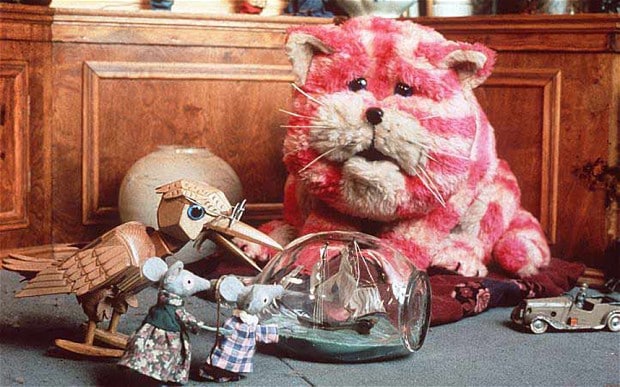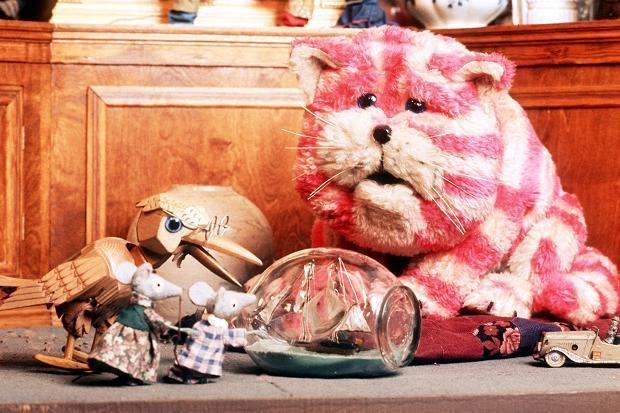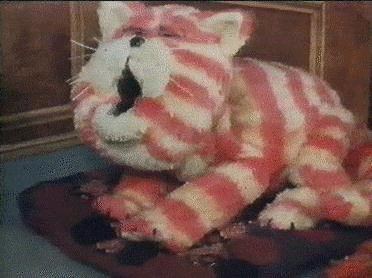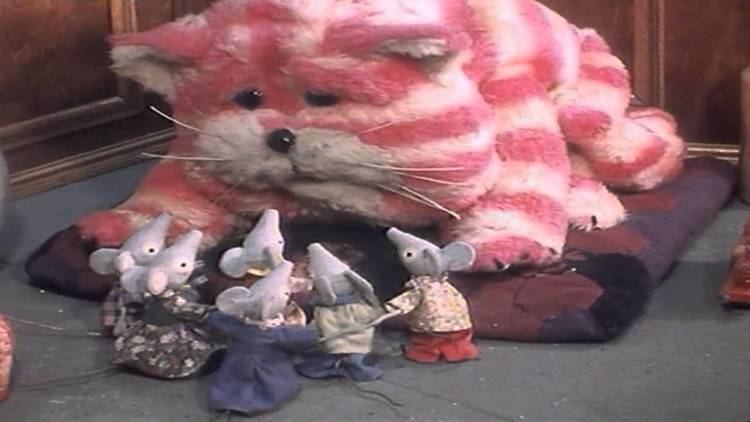7.6 /10 1 Votes
7.3/10 TV No. of episodes 13 First episode date 12 February 1974 | 8/10 IMDb Country of origin United Kingdom Original network BBC1 Final episode date 7 May 1974 | |||||||||||||||||||||||||||||||||
Original release 12 February – 7 May 1974 Similar Clangers, Ivor the Engine, Noggin the Nog, Roobarb, Camberwick Green | ||||||||||||||||||||||||||||||||||
Bagpuss is a British children's television series, made by Peter Firmin and Oliver Postgate. The series of 13 episodes was first broadcast from 12 February 1974 to 7 May 1974 through their company Smallfilms. The title character was "a saggy, old cloth cat, baggy, and a bit loose at the seams". Although only 13 episodes were made, it remains fondly remembered, and was frequently repeated in the UK for 13 years. In 1999 Bagpuss topped a BBC poll for the UK's favourite children's TV programme.
Contents
- Bagpuss opening titles classic uk kids tv
- Format
- Title sequence
- Episodes
- Production
- Recognition
- Home media
- References

Bagpuss opening titles classic uk kids tv
Format

Each programme began in the same way: through a series of sepia photographs, the viewer is told of a little girl named Emily (played by Emily Firmin, the daughter of illustrator Firmin), who owned a shop. Emily found lost and broken things and displayed them in the window, so their owners could come and collect them; the shop did not sell anything. She would leave the object in front of her favourite stuffed toy, the large, saggy, pink and white striped cat named Bagpuss, originally intended by Firmin to be a retired Indian Army cat who entertained children in the hospital with his "visible" thoughts appearing in a "thinks bubble" above his head. When Postgate and Firmin were asked to develop this character for a BBC programme Postgate placed him in the shop with other characters and his "thinks bubble" became a way to illustrate the stories and mend or explore the objects that Emily had found. Emily then recited a verse:

Bagpuss, dear Bagpuss
Old Fat Furry Catpuss
Wake up and look at this thing that I bring
Wake up, be bright, be golden and light
Bagpuss, oh hear what I sing

When Emily had left, Bagpuss woke up. The programme shifted from sepia to colour stop motion film, and various toys in the shop came to life: Gabriel the toad (who, unlike most Smallfilms characters, could move by a special device beneath his can without the use of stop motion animation) and a rag doll called Madeleine. The wooden woodpecker bookend became the drily academic Professor Yaffle (based on the philosopher Bertrand Russell, whom Postgate had once met), while the mice carved on the side of the "mouse organ" (a small mechanical pipe organ that played rolls of music) woke up and scurried around, singing in high-pitched voices. Sandra Kerr and John Faulkner provided the voices of Madeleine and Gabriel respectively, and put together and performed all the folk songs. All the other voices (including the narrator and one out-of-tune mouse) were provided by Postgate, who also wrote the stories.

The toys discussed what the new object was; someone (usually Madeleine) would tell a story related to the object (shown in an animated thought bubble over Bagpuss's head), often with a song, accompanied by Gabriel on the banjo (which often sounded a lot more like a guitar), and then the mice, singing in high-pitched squeaky harmony to the tune of Sumer Is Icumen In as they worked, mended the broken object. The newly mended thing was then placed in the shop window, so that whoever had lost it would see it as they went past, and could come in and claim it. Then Bagpuss would start yawning again, and as he fell asleep the narrator would speak as the colour faded to sepia and they all became toys again.

And so their work was done.
Bagpuss gave a big yawn and settled down to sleep
And, of course, when Bagpuss goes to sleep,
All his friends go to sleep too.
The mice were ornaments on the mouse organ.
Gabriel and Madeleine were just dolls.
And Professor Yaffle was a carved, wooden bookend in the shape of a woodpecker.
Even Bagpuss himself, once he was asleep, was just an old, saggy cloth cat,
Baggy, and a bit loose at the seams,
But Emily loved him.
Title sequence
The scene is set at the turn of the 20th century, with Emily Firmin playing the part of the Victorian child Emily. The first antique village vignette is a cropped image of Horrabridge taken in 1898, though nothing is known of the other photo of the children with the pram. The shop window was at the Firmin family home in Blean.
Episodes
The episodes used to be on at 1:45pm on BBC1 and the titles of the episodes each refer in some way to the object Emily found.
Production
The programmes were made using stop-frame animation. Bagpuss is an actual cloth cat, but was not intended to be such an electric pink. "It should have been a ginger marmalade cat but the company in Folkestone dyeing the material made a mistake and it turned out pink and cream. It was the best thing that ever happened," said Firmin.
Madeleine the rag doll was made by Firmin's wife, Joan, with an extra long dress to hold their children's nightdresses, but Postgate asked Joan to make a new version as one of the characters.
Gabriel the Toad was the only character in the series who could move freely without the use of stop-frame animation. Scenes featuring him playing the banjo and singing would have taken quite a bit of time if filmed with the stop-frame method, so Peter Firmin created a mechanism that helped him control Gabriel through a hole in his can.The character was based on a real toad that lived in the basement area of the flat that Peter and Joan Firmin rented in Twickenham beside the River Thames. Peter first made Gabriel (named after Walter Gabriel in The Archers, a long-running British radio soap opera) for his live ITV programme "The Musical Box". Oliver chose him as one of the characters in Bagpuss and Peter made a new, slightly larger version.
Professor Yaffle was created as the Bookend who had access to "facts". The BBC did not like Peter's first character, a man in top hat made from Black Irish bogwood called "Professor Bogwood". They thought it was too frightening and asked for a non-human instead.
Bagpuss has now retired to the Rupert Bear Museum in Canterbury, part of the Museum of Canterbury, together with other characters and Emily's shop window.
Most of the stories and songs used in the series are based on folk songs and fairy tales from around the world.
Recognition
In 1987 the University of Kent at Canterbury awarded honorary degrees to Postgate and Firmin. In his speech, Postgate stated that the degree was really intended for Bagpuss, who was subsequently displayed in academic dress.
In 1999 the series came first in a BBC poll selecting the nation's favourite children's show. It also came fourth in the 2001 Channel 4 poll, the 100 Greatest Kids' TV shows.
In 2002 and 2005 a stage show of Bagpuss songs toured UK folk festivals and theatres with original singers Sandra Kerr and John Faulkner, along with Kerr's daughter Nancy Kerr and her husband, James Fagan.
In June 2002, the charity Hospices of Hope opened the Bagpuss Children's Wing in its hospice in Brașov, Romania. The wing was funded entirely by Postgate from royalties received from the BBC. In April 2012, Marc Jenner from Tunbridge Wells in Kent ran in the Virgin London Marathon dressed in a 7-foot (2.1 m) Bagpuss costume to raise money for the charity, supported by Emily Firmin and Postgate's family.
Thom Yorke of the band Radiohead has claimed to be a fan of the show, watching it with his son. It was an influence for 2003 album Hail to the Thief. Gabriel's song in Episode 2 was the acknowledged inspiration for the album track (and first single) "There There" (originally titled "The Bony King of Nowhere").
The character appeared on one of the twelve postage stamps issued by Royal Mail in January 2014 to celebrate classic children's programmes.
Home media
In May 1999, PolyGram released a video entitled The Complete Bagpuss which included all 13 episodes. It was released in DVD format in April 2005. It was re-released in DVD format in April 2015.
The first video was released by Channel 5 and the rest were released by Universal Pictures.
